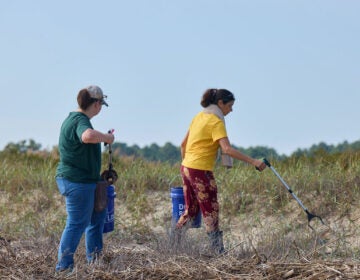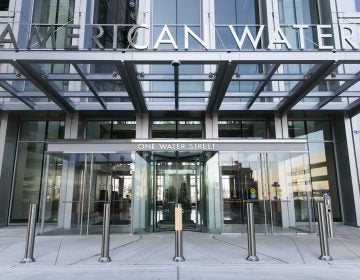‘Biggest of its kind’: Living shoreline project to save Barnegat Bay beachfront
It’s hoped that steel cages, rocks, shells and 70 million juvenile oysters will finally turn the tide on the massive erosion threatening beaches and beachfront houses.
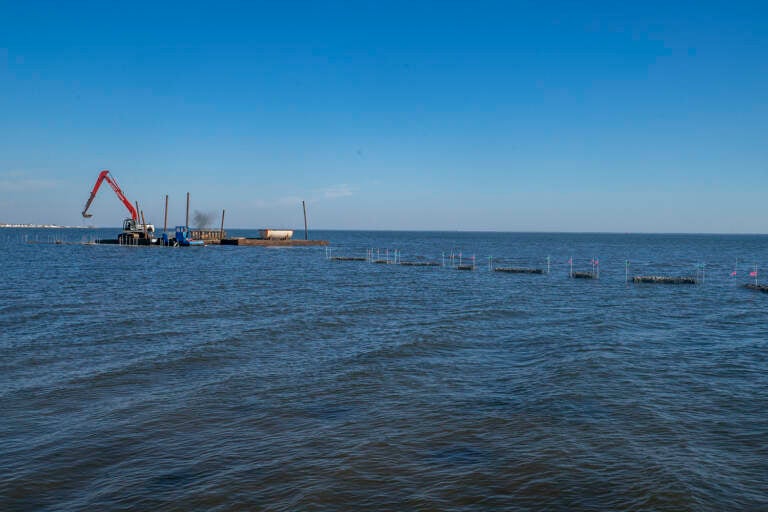
A living reef is being built along the Barnegat Bay shoreline to stop the beachfront from washing away. (Andrew S. LewisNJ Spotlight)
This story originally appeared on NJ Spotlight.
For the past eight years, the Highlands-based American Littoral Society and partner Stockton University, along with concerned community members, have been quietly bringing to life a living shoreline project on Barnegat Bay. When completed, according to the society’s Executive Director Tim Dillingham, it will be “the biggest of its kind going on in New Jersey, so far.”
In November, the first of 168 four-by-three-foot, rock-filled, steel-wire cages were dropped into the water off the Lacey Township community of Forked River Beach. With three barges and three excavators, workers and volunteers have until the end of December to transform 1,000 tons of rock into seven, 200-foot-long reefs, arranged in a sawtooth pattern between 100 and 200 feet off the beach. Next year, crews will return to fill the exterior pockets that have been added to the cages with recycled whelk, clam and oyster shells. HESCO, the company that manufactures the cages, also specializes in body armor and “accommodation bunkers” to keep personnel safe in hostile territory.
“This is truly a community-based restoration project that’s been a partnership between volunteers, private, public, and nonprofit entities from the beginning,” said the Littoral Society’s Captain Al Modjeski, who is leading the effort, officially called the Forked River Beach Living Shoreline Project. “The hope is this can be used as a model for other projects in Barnegat Bay and beyond.”
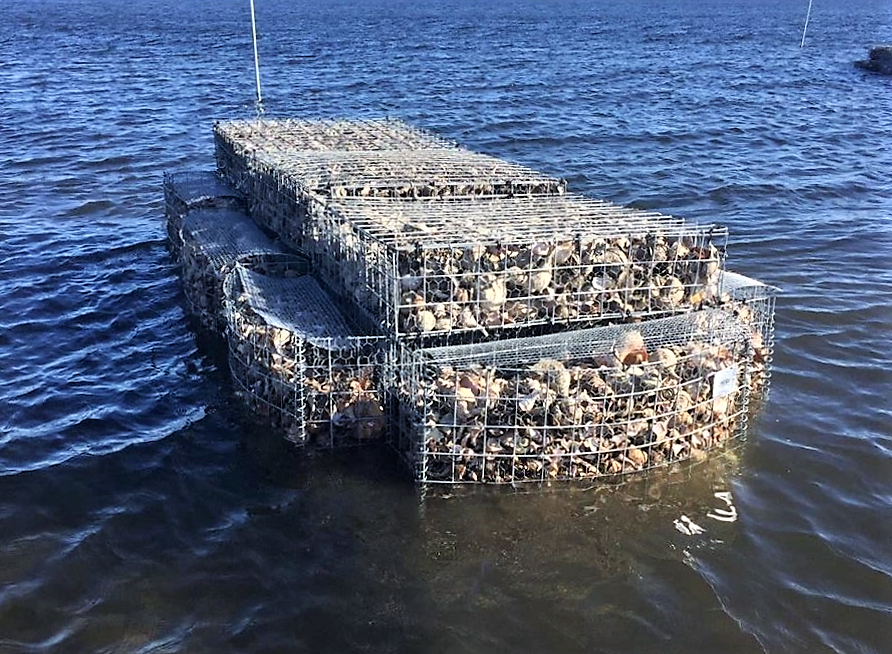
Building back a better shoreline
Funded with a $1 million grant from the state’s Department of Environmental Protection, the project’s long-awaited start comes with the passage of President Joe Biden’s Infrastructure Investment and Jobs and Build Back Better acts. Dillingham said both “speak to climate adaptation” and contain funding that can be directed to help places like the state’s Barnegat and Delaware bays better prepare for intensifying sea-level rise and other effects of climate change.
Some $6 billion in the Build Back Better Act is earmarked for coastal resiliency that is modeled after Congressman Frank Pallone (NJ-06) and other lawmakers’ “Living Shorelines Act,” which calls for federal funding for shoreline infrastructure projects that use natural materials and buffer systems, like dunes, wetlands and oyster reefs.
At the same time, and across the aisle, Congressman Jeff Van Drew (NJ-02) is touting his own “Stronger Shores” initiative, which calls for tapping Biden’s $1.2 trillion Infrastructure Investment and Jobs Act to bolster beach replenishment and back-bay dredging throughout coastal New Jersey.
The Forked River Beach Living Shoreline Project is hardly the first attempt to save this low-lying, densely developed lobe of land, which stretches for just under a half-mile, between the mouth of Forked River to the north and a lagoon entrance to the south.
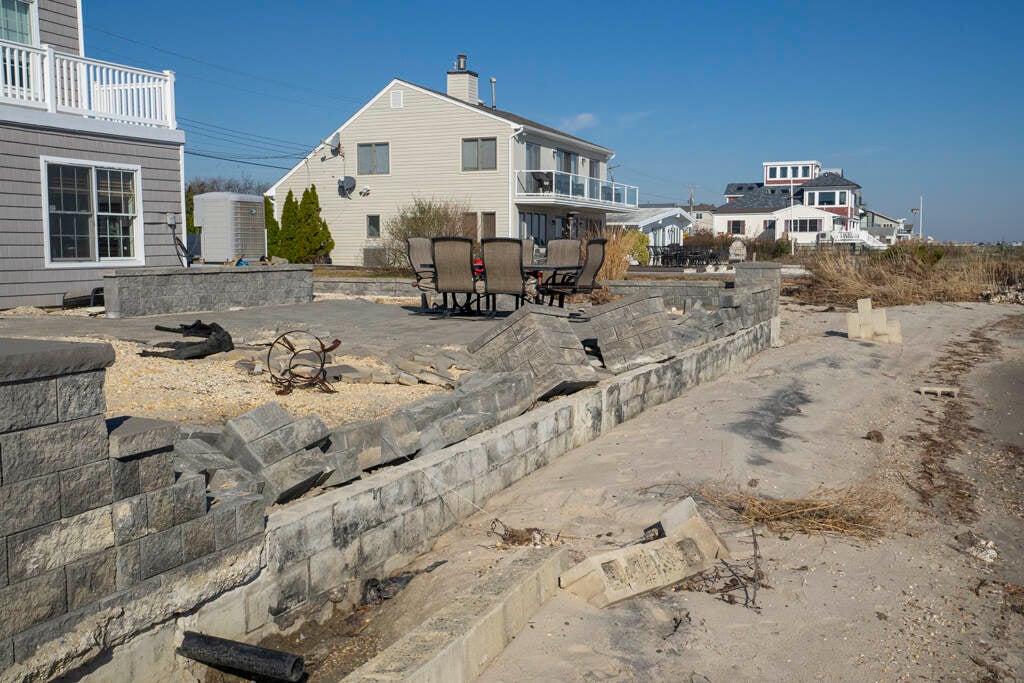
Shoreline loss nothing new
According to the Littoral Society, over a hundred feet of shoreline has eroded here since 1995. In response to the rapid rate of land loss, the township installed a riprap — crushed rock and stone — perimeter along the northern flank of the area, where a roughly five-acre public park sits along the water’s edge.
After superstorm Sandy scattered the riprap and severely damaged the park, as well as inundated residents’ homes, the township received a grant to rebuild the park and fortify the land with a barrier of large, rock-filled metal cages called gabions.
The gabion barrier was completed in 2017 and has so far held together the earth behind it. But it has also triggered a classic side effect of this type of traditional beachfront hardening. Just beyond its southern terminus, the unfortified shoreline, which is owned privately by the Bayside Beach Club, has become severely scarped, leaving little earth between open water and homeowners’ back steps. (A groin installed years ago has also contributed significantly to the erosion.) In 2017 alone, as construction of the gabion barrier finished, the shoreline here eroded by 20 feet.
Since Sandy, several piecemeal attempts have been made by the Bayside Beach Club and individual homeowners, in the form of piles of mesh bags filled with welk shells, boulders and cinderblock walls. All have failed.
No property has suffered more than that of Tony Fiani, nor has any homeowner appeared to have fought back against the water more.
Fiani built his four bedroom, 5,000-square-foot home here in 2008. One of its nicest features, Fiani said, is a spacious brick patio that offers an unobstructed view of Barnegat Bay and Island Beach State Park on the distant horizon. A decade ago, a wide swath of sandy shoreline blanketed with grasses stood between the patio and the water.
“For the flood insurance company, I had to measure from the back of the house to where you first hit water — it was 132 feet,” Fiani said. “Now, from my house to the water, there’s only 32 feet left.”
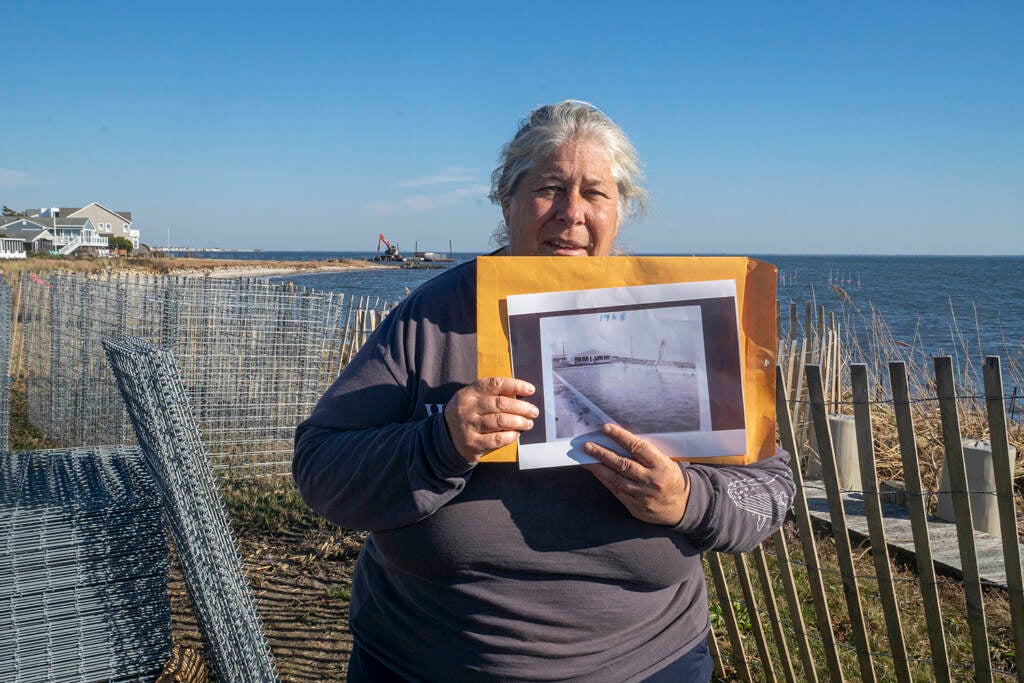
One brick at a time
Over the years, Fiani has tried to fortify his property with cinderblocks, shell bags and other ad hoc measures, but none have stopped the bay from gnawing away his patio, brick by brick. This past October’s nor’easter, Fiani said, was particularly destructive.
“The bay was higher than normal,” he said. “It was the worst I’ve seen in years.”
By 2050, coastal communities throughout New Jersey will see at the very minimum seven more inches of sea level rise above those recorded in 2000, a year in which sea level in the state had already risen more than a foot above that of 1900. Seven inches, let alone 2.1 feet, of which Rutgers University says there is a 17% chance, could very well render beachfront properties like Fiani’s uninhabitable.
In the face of such rise, traditional shoreline rebuilding efforts are proving insufficient — or, in the case of the gabion wall, even destructive. Groups like the Littoral Society and universities like Stockton are counting on fresh approaches like the Forked River reef to usher in a new, more effective and holistic era in coastal resiliency.
Up until the early 1900s, there was an estimated 12,000 acres of oysters throughout Barnegat Bay — nearly all of which have vanished due to overfishing, pollution and disease. “That key part of the bay’s ecological system is gone,” Dillingham said.
Next spring, some 70 million juvenile oysters, or spat, grown by Ocean County shellfisherman Dale Parsons, will be distributed across the inner section of the reef. The hope is that the oysters will set onto the HESCO cages’ shell exteriors and expand to the outer section of the reef and beyond. As the reef grows, it will increasingly absorb the bay’s wave energy, rendering the waters between it and the shoreline not only clear, which will stimulate the growth of submerged aquatic vegetation and other marine species, but also calm, which will reduce the gnawing effect of open water currents, thus reducing erosion.
Avoiding hard structures
“What we’re trying to do,” Dillingham continued, “is protect property through a nature-based system without having to resort to these hard structures, which destroy the shoreline and create a deficit in ecological value.”
Modjeski agreed. “We just need reefs to grow oysters on,” he said. “They’ll help build the needed resiliency and lessen the rate of shoreline erosion.”
Longtime Forked River Beach homeowner Pat Doyle was one of the first residents to begin raising awareness of the erosion. Through meetings with Captain Modjeski and his Littoral Society colleagues, as well as coastal resiliency experts at Stockton University, Doyle has come to believe living shorelines are the best way forward for at-risk communities like hers.
“What’s the definition of crazy? Doing the same thing over and over,” said Doyle, referring to what she views as the failures of traditional shoreline hardening.
Standing at the staging ground where volunteers and contractors were busy readying the HESCO cages to be barged out to the project site, filled with rock, and dumped overboard, Doyle held up a black-and-white photograph, taken in 1968, of a large pool that was once a centerpiece of the Bayside Beach Club. The pool, Doyle explained, sat between the homes and the bay — an area that is completely underwater today.
She was dismayed at how the state, township, beach club and homeowners have been working independent of one another for so many years. The fractured efforts, she said, had resulted in this mutilated, astonishingly diminished strip of shoreline.
“We need to work in a unified way,” Doyle said. “And we haven’t been doing that.”
Between Doyle and Fiani’s homes was an empty lot that was recently purchased by Kelly Norton and her husband, Chris. Norton, who said she and Chris had never lived at the beach before, had bought the property with the “pipe dream” of building a home and retiring here for the rest of their lives. Like Fiani’s, Norton’s property has also experienced significant land loss in recent years.
“The pipe dream,” she said, “has become a nightmare.”
After acquiring their slice of Barnegat Bay beachfront, the Nortons had learned about all the desperate, ultimately futile piecemeal efforts that had been attempted over the years.
She admitted that when she saw the Littoral Society drop the first huge, rock-filled cages offshore for the pilot stage of the project last winter, “I was, like, what is that eyesore out there?” But after talking with neighbors like Doyle and Fiani, as well as Modjeski and other project partners, Norton’s opinion on living shorelines began to shift.
“For New Jersey, this place is a gem, not just for the people who live here, but for our grandchildren and for the tourists that come,” Norton said. “We are the people who are destroying it, and we need to help fix it — and this project is what’s going to help us.”
WHYY is your source for fact-based, in-depth journalism and information. As a nonprofit organization, we rely on financial support from readers like you. Please give today.




